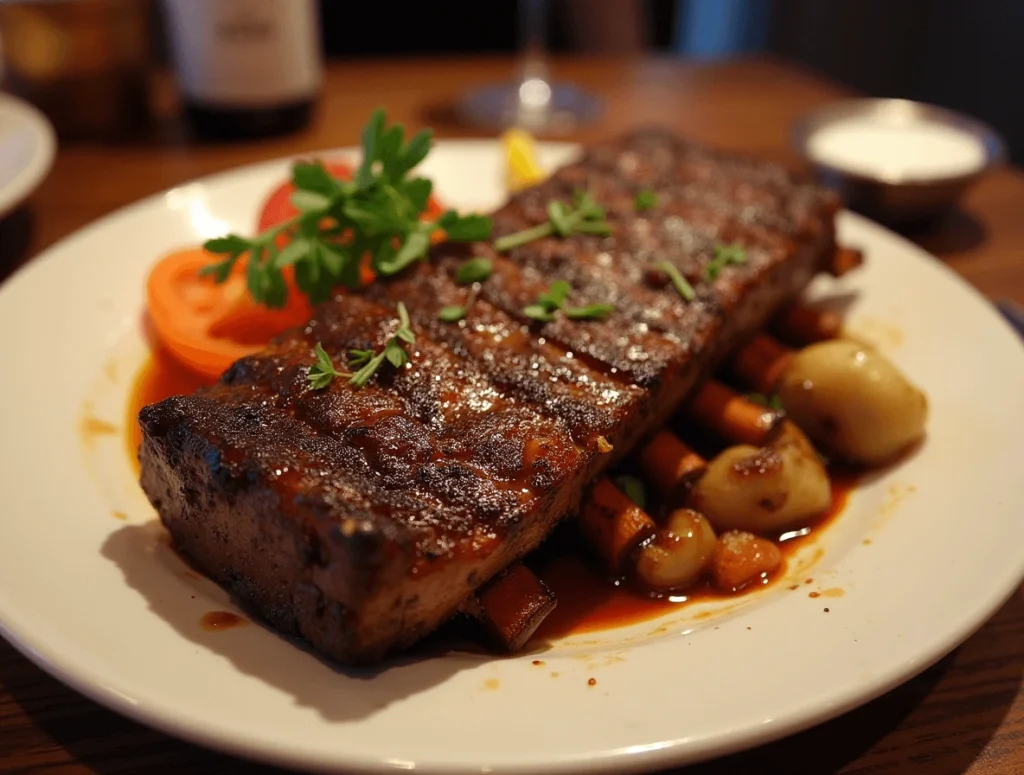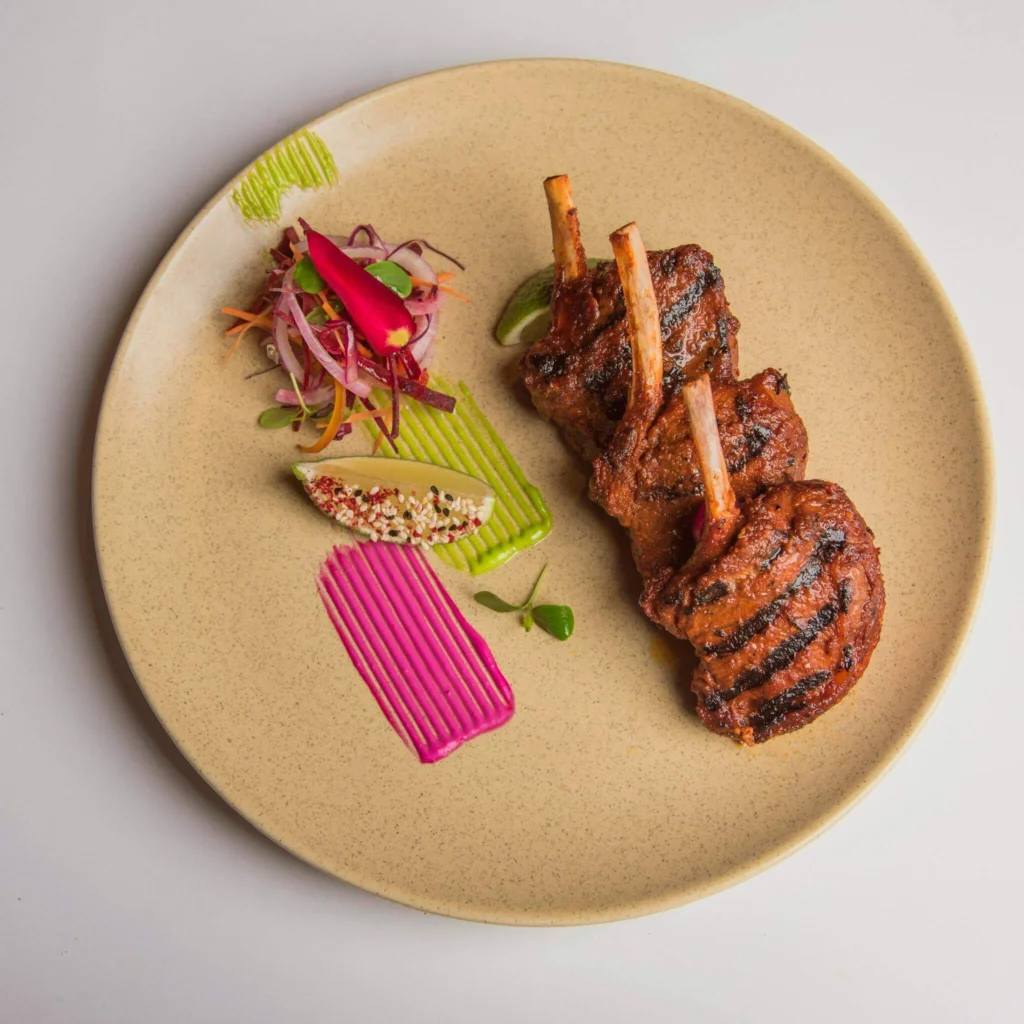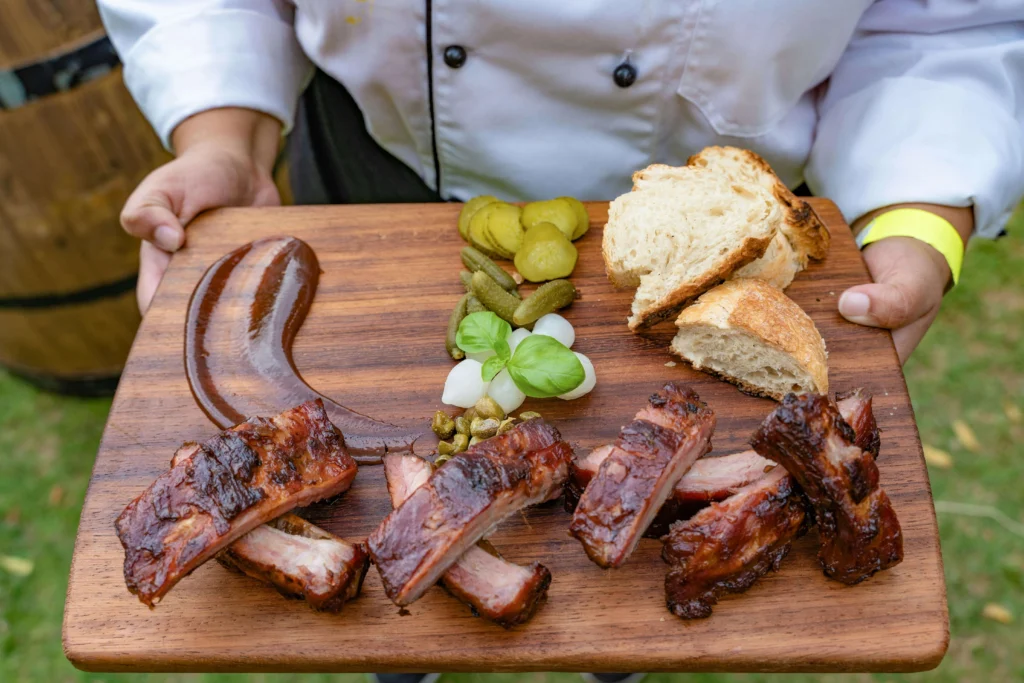If you’re looking for a meal that’s packed with bold, smoky flavor and melt-in-your-mouth tenderness, you can’t go wrong with a beef back ribs recipe. These ribs are taken from the upper part of the rib cage, close to the backbone, and are known for their rich, beefy taste. While they have less meat compared to short ribs, beef back ribs shine when cooked low and slow, allowing the meat to absorb flavors and become perfectly tender.
In this post, we’ll share an easy-to-follow beef back ribs recipe that’s perfect for BBQs, Grilling, or oven baking. You’ll learn how to season, cook, and serve these delicious ribs so they turn out juicy and flavorful every time. Whether you’re a beginner or a seasoned cook, this guide will help you make mouthwatering ribs with minimal effort!

Table of Contents:
¶ What Are Beef Back Ribs?
Beef back ribs are a specific cut of beef taken from the upper section of the cow’s ribcage, right next to the prime rib roast. These ribs feature long, curved bones with meat surrounding and between them. Unlike other cuts of beef, such as short ribs, beef back ribs are generally leaner with less meat directly on top of the bones. While not as meaty as other rib cuts, beef back ribs stand out due to their rich, beefy flavor, making them a favorite for BBQ lovers and those who appreciate bold, hearty dishes. They can be slightly overlooked when compared to pork ribs, but when cooked properly, beef back ribs offer a unique texture and depth of flavor that make them well worth considering for your next BBQ or slow-cooked meal.
**🔹Overview of Beef Back Ribs
One of the main differences between beef back ribs and other types of ribs—such as short ribs or spare ribs—lies in the location from which they are cut and the amount of meat they contain. Short ribs, for example, come from the lower portion of the ribcage and contain more meat along with higher fat content. This makes short ribs incredibly rich and tender, especially when braised or slow-cooked. Beef back ribs, on the other hand, are cut from the upper rib section, near the prime rib roast, which results in a leaner cut with more meat between the bones and less fat surrounding it. This gives them a different texture, one that’s ideal for slow cooking methods like roasting, smoking, or braising. While beef back ribs may not have as much fat, they still deliver a wonderfully beefy flavor, especially when cooked with the right seasoning and method.
**🔹Flavor and Texture
Beef back ribs are known for their bold, beefy flavor. The taste is deeper and richer compared to other rib types due to the lean nature of the meat and the natural marbling between the bones. When cooked slowly, the meat becomes tender with a slightly chewy bite, offering a satisfying texture with each mouthful. The meat, though leaner, absorbs flavors very well, making it a perfect candidate for seasoning, marinades, or BBQ glazes. If grilled or roasted, the meat can develop caramelized edges, adding both a crispy texture and additional flavor complexity. Slow roasting, smoking, or braising are the best methods to cook beef back ribs, as these methods break down the tough connective tissue and allow the ribs to become fall-off-the-bone tender.
**🔹Best Cuts to Choose
When buying beef back ribs, the quality of the cut matters for achieving the best results. Look for ribs with a good amount of meat between the bones, as some pre-packaged ribs may have been trimmed too close, leaving mostly bone with very little meat. Ideally, choose beef back ribs with visible marbling, as this is an indicator of good quality and flavor. The marbling helps keep the meat moist and adds richness when cooked. The color of the meat should be a deep red, which indicates freshness. If possible, request a full rack of beef back ribs from your butcher, as this will ensure you get a good portion of meat on each bone, offering a more satisfying meal overall. Full racks tend to have more consistency in texture, and the meat between the bones will be more evenly distributed, giving you better results during cooking.
This expanded version includes additional details on the difference between beef back ribs and other cuts, providing a thorough explanation of flavor, texture, and how to choose the best cuts.
¶ How to Cook Beef Back Ribs – Step-by-Step

Cooking beef back ribs may seem intimidating, but with the right preparation and techniques, it’s easier than you think to achieve tender, juicy ribs packed with flavor. Follow this step-by-step guide to get perfect results every time.
✅ Step 1: Preparing the Ribs
Before cooking your beef back ribs, proper preparation is essential to ensure they turn out flavorful and tender.
- Trimming Excess Fat and Removing the Membrane
- Check your ribs for excess fat and trim it away using a sharp knife. While some fat is necessary for flavor and moisture, too much can result in greasy ribs.
- Flip the ribs over and remove the silver membrane (located on the bone side). This tough layer can prevent seasonings from penetrating the meat and make the ribs chewy. Use a knife to loosen one corner, then grip it with a paper towel and pull it off in one clean motion.
- Seasoning the Ribs
- Dry Rub: A dry rub is a great way to enhance the natural flavor of the beef. Use a blend of salt, pepper, garlic powder, paprika, and your favorite spices for a classic BBQ flavor.
- Marinade: If you prefer deeper flavor and extra moisture, marinate the ribs for a few hours or overnight. Common marinade ingredients include soy sauce, Worcestershire sauce, garlic, and brown sugar for a sweet-savory profile.
✅ Step 2: Cooking Methods
There are two popular methods for cooking beef back ribs: oven baking and grilling. Both produce delicious results, so it depends on your preference and available equipment.
- Oven-Baked Beef Back Ribs – Low and Slow Method
- Preheat your oven to 275°F (135°C).
- Place the seasoned ribs on a baking sheet lined with foil. Cover them with another layer of foil to lock in moisture.
- Bake for 2.5 to 3 hours until the meat becomes tender. For the final 20 minutes, remove the top layer of foil and brush the ribs with BBQ sauce, then increase the temperature to 400°F (200°C) to caramelize the sauce.
- Grilled Beef Back Ribs – Adding a Smoky, Charred Flavor
- Preheat your grill to medium heat (around 300°F/150°C). Use indirect heat by placing the ribs on the side of the grill without direct flames.
- Grill the ribs for about 2.5 to 3 hours, turning occasionally and basting with BBQ sauce during the last 30 minutes for a sticky, caramelized finish.
✅ Step 3: Checking for Doneness
To ensure your beef back ribs are perfectly cooked, check for doneness using these tips:
- Internal Temperature: The ribs should reach an internal temperature of 190°F to 203°F (88°C to 95°C) for the best tenderness.
- Visual Cues: The meat should pull back slightly from the bones, and you should be able to insert a fork easily into the meat.
- Bone Test: Give one of the bones a gentle twist. If it moves freely without much resistance, your ribs are done.
After cooking, let the ribs rest for 10 minutes before slicing to allow the juices to redistribute. Serve with your favorite sides and enjoy!
¶ Tips for Perfect Beef Back Ribs Every Time
Achieving perfect beef back ribs requires attention to detail and a few key tips that will elevate your dish. Here’s how to ensure your ribs turn out tender, flavorful, and fall-off-the-bone delicious every time you cook them.
**🔹Use a Flavorful Dry Rub
The seasoning you use on your beef back ribs can make all the difference. A well-balanced dry rub enhances the natural flavor of the meat and helps create a flavorful crust when cooked. You can customize your rub based on your taste preferences—consider adding:
- Smoked Paprika for a smoky depth.
- Brown Sugar for a touch of sweetness that balances savory flavors.
- Chili Powder or Cayenne Pepper if you like a bit of heat.
- Garlic Powder and Onion Powder for a savory kick.
Experiment with different herbs and spices to create a signature blend that complements the beefy flavor of the ribs. Apply the rub generously on both sides and press it into the meat for maximum flavor penetration.
**🔹Don’t Rush the Cooking Process
Slow and steady wins the race when it comes to beef back ribs. Rushing the cooking process can lead to tough, chewy ribs that don’t have time to tenderize properly.
- Low and Slow: Whether baking or grilling, the key to tender ribs is cooking them at a low temperature for a long period. This allows the connective tissue to break down, turning tough meat into juicy, fall-apart goodness.
- Patience is Key: Give your ribs the time they need to cook properly. While it may be tempting to increase the heat to speed things up, cooking too quickly can result in dry or rubbery meat. Aim for 2.5 to 3 hours at a consistent, low heat to achieve the perfect texture.
**🔹Basting and Glazing
Adding BBQ sauce or a glaze to your beef back ribs at the right time enhances both flavor and texture. But timing is important to avoid burning the sauce or overpowering the meat.
- When to Apply: Begin basting the ribs with BBQ sauce or a glaze about 30 minutes before they’re done cooking. This allows the sauce to caramelize and form a sticky, flavorful coating.
- How to Apply: Use a brush to lightly coat the ribs, ensuring an even layer. Avoid slathering on too much sauce, as it can overwhelm the natural flavor of the meat. Continue basting every 10 minutes until the ribs are fully cooked, allowing the sauce to build up and intensify.
- Optional Glaze: For a unique twist, you can use a combination of honey, soy sauce, or balsamic vinegar as a glaze to balance sweetness and tang.
**🔹Resting the Ribs
Once your beef back ribs are cooked to perfection, don’t rush to slice them immediately. Letting the ribs rest is a crucial step to lock in juices and maintain tenderness.
- Let them Rest: After removing the ribs from the grill or oven, tent them loosely with foil and let them rest for 10–15 minutes. This gives the meat time to reabsorb its juices, ensuring that every bite is juicy and flavorful.
- Slicing: When cutting the ribs, use a sharp knife or a pair of kitchen shears to slice between the bones, preserving the tender texture of the meat.
By following these tips, you’ll be able to consistently create beef back ribs that are bursting with flavor and perfectly tender every time you cook them.

¶ Conclusion
In this post, we’ve shared everything you need to know to make the perfect beef back ribs. From understanding what makes beef back ribs so delicious and how to select the best cut, to preparing and cooking them with a variety of methods, we’ve covered all the essentials. By following the step-by-step instructions, you’ll be able to create juicy, tender ribs every time.
Remember, the key to great beef back ribs lies in proper preparation, a flavorful seasoning blend, and giving them the time they need to cook low and slow. Whether you choose to bake them in the oven or throw them on the grill, don’t forget to baste with BBQ sauce at the right time and let them rest before slicing to ensure maximum flavor and tenderness.
Now it’s your turn! We encourage you to try this beef back ribs recipe and experiment with your own seasoning blends and cooking methods. Once you’ve perfected your ribs, be sure to share your experience—whether it’s a photo or your personal twist on the recipe. We’d love to hear about your delicious results! Happy cooking!
*** Gist Recipes ***
Reviews:
There are no reviews yet. Be the first one to write one.


1 thought on “How to Cook Beef Back Ribs: Easy and Delicious Recipe”
Comments are closed.